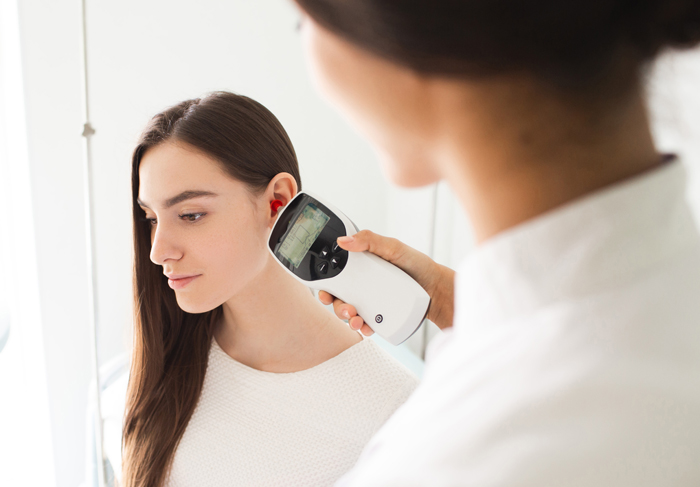Best Audiometry Procedure in Alwarpet, Chennai
Hearing loss or presbycusis occurs gradually with age due to chronic exposure to loud noises or excessive earwax. Hearing loss cannot be reversed in many cases. Audiometry is a simple procedure to diagnose hearing loss in adults and children by an ENT specialist near you.

What do we need to know about audiometry?
Humans can hear sound waves with the frequency ranging between 20 and 20,000 Hz. Audiometry tests the intensity and tone of the sound, balancing problems and other issues related to the functioning of the inner ear. Pure tone test helps measure the quietest sound that you can hear at a different pitch. Audiometry tests mechanical sound transmission (functioning of the middle ear), neural sound transmission (functioning of the cochlea) and speech discrimination ability.
What are the types of audiometry?
- Pure-tone audiometry – It is done to check your hearing threshold or capacity for using the sound of the same tone but at different frequencies.
- Speech audiometry – It checks the working of the entire auditory system with the help of a speech discrimination test and speech reception threshold test.
- Suprathreshold audiometry – This helps check whether a listener can recognize speech or not and determines the improvement witnessed in people using hearing aids.
- Self-recording audiometry - In this test, a motor can automatically change the intensity and frequency of sound with the help of an attenuator.
- Impedance audiometry – This measures the reflexes of the middle ear along with the mobility and air pressure in it.
- Subjective audiometry – A listener has to respond after hearing a sound and responses are recorded.
What are the risk factors?
Audiometry is a non-invasive test, hence it has no side effects or risks associated with it.
How do you prepare for audiometry?
An audiometer is an electric device consisting of:
- Pure tone generator
- Bone conduction oscillator
- Attenuator to vary the loudness
- Microphone to test speech
- Earphones
Pure tone test is performed using an audiometer that is a machine that produces sound via headphones. The audiologist will play the sound of varying tones and speech at different time intervals in one ear at a time. It is done to check the range of your hearing. In another test, you need to repeat the words you heard in the sound sample. In the third test, the audiologist will put a tuning fork or bone oscillator against the bone behind your ear (mastoid bone), to determine how well the vibrations are passing through the bone to your inner ear.
What can you expect from audiometry?
If you can hear the sound played in the pure tone test, you must raise your hand. In the second test, if you can speak the correct words from the sample, you are not suffering from hearing loss. In the third test, if the vibrations don’t pass from your mastoid bone to the inner ear, then it is an indication of hearing loss.
What are the possible results of audiometry?
The hearing ability is measured in decibels and is represented on an audiogram. People usually speak at 60 decibels and shout at 8 decibels. If you cannot hear the sound with the following intensity, then it indicates the severity of hearing loss:
- Mild hearing loss: 26 - 40 decibels
- Moderate hearing loss: 41 - 55 decibels
- Moderate - severe hearing loss: 56 - 70 decibels
- Severe hearing loss: 71 - 90 decibels
- Profound hearing loss: 91 - 100 decibels
When do you need to see a doctor?
If you are facing difficulty in hearing, particularly in one ear, and cannot understand the spoken words, then you must visit an ENT specialist near you. ENT specialists help diagnose the intensity of hearing loss and suggest a way to treat it.
Request an appointment at Apollo Spectra Hospitals, Alwarpet,Chennai.
Call 1860 500 2244 to book an appointment.
Conclusion
After audiometry, you might or might not be diagnosed with significant hearing loss, depending upon the volume and tone of sound that you can hear. An ENT specialist near you will suggest preventive measures like earplugs for loud noise or hearing aid to lessen further damage.
There are several reasons for hearing loss, including:
- Birth defects
- Injury to ear
- Ruptured eardrum
- Autoimmune disease
- Chronic ear infection
- Regular exposure to loud sound
An audiogram is a chart that shows how well you can hear sounds of different frequencies and pitches, different intensities and varying loudness.
If you are suffering from moderate hearing loss, i.e. you cannot hear sound between 40 and 60 dB, then your ENT specialist will recommend a hearing aid.
The hearing capacity of a person usually decreases with age due to changes in the structure of the middle ear, along with the nerve connection in the ear and the brain.
Symptoms
Our Doctors
DR. DEEPIKA JEROME
BDS...
| Experience | : | 14 Yeras Experience |
|---|---|---|
| Speciality | : | Dental and Maxillofa... | Location | : | MRC Nagar |
| Timings | : | Mon - Sat : 9:30 AM ... |
DR. PRABHA KARTHIK
MBBS, DNB...
| Experience | : | 7 Yeras Experience |
|---|---|---|
| Speciality | : | ENT, Head and Neck S... | Location | : | Alwarpet |
| Timings | : | Mon - Fri - 12:30p... |
DR. SUNDHARI V
MBBS, DNB...
| Experience | : | 27 Yeras Experience |
|---|---|---|
| Speciality | : | ENT, Head and Neck S... | Location | : | Alwarpet |
| Timings | : | Mon - Sat : 10:00 AM... |
DR. ELANKUMARAN K
MBBS, MS (General Su...
| Experience | : | 20 Yeras Experience |
|---|---|---|
| Speciality | : | General Surgery & Ga... | Location | : | Alwarpet |
| Timings | : | Available by prior a... |
DR. SATHYA NARAYANAN
MBBS, MS (ENT)...
| Experience | : | 4 Yeras Experience |
|---|---|---|
| Speciality | : | ENT, Head and Neck S... | Location | : | Alwarpet |
| Timings | : | Mon - Sun : 2:00 PM ... |
DR. M BARATH KUMAR
MBBS, MD (INT.MED), ...
| Experience | : | 12 Yeras Experience |
|---|---|---|
| Speciality | : | General Surgery & Ga... | Location | : | Alwarpet |
| Timings | : | Wed : 3:30 PM to 4:3... |
DR. ANAND L
MS, MCh (GASTRO), FR...
| Experience | : | 21 Yeras Experience |
|---|---|---|
| Speciality | : | General Surgery & Ga... | Location | : | MRC Nagar |
| Timings | : | Mon - Sat : 8:00 PM ... |
DR. KARTHIC BABU NATARAJAN
MBBS,MD, DNB...
| Experience | : | 13 Yeras Experience |
|---|---|---|
| Speciality | : | Pain Management... | Location | : | MRC Nagar |
| Timings | : | On Call... |
DR. MURALEEDHARAN
MBBS,MS (ENT), DLO...
| Experience | : | 34 Yeras Experience |
|---|---|---|
| Speciality | : | ENT, Head and Neck S... | Location | : | MRC Nagar |
| Timings | : | Mon - Sat : 4:30 PM ... |
DR. SHEERIN SARAH LYSANDER
MBBS, MD(Anesthesiol...
| Experience | : | 8 Yeras Experience |
|---|---|---|
| Speciality | : | Pain Management... | Location | : | MRC Nagar |
| Timings | : | Mon - Sun : 7:00 AM ... |
DR. ADITYA SHAH
MBBS, MD, DM (Gastro...
| Experience | : | 6 Yeras Experience |
|---|---|---|
| Speciality | : | General Surgery & Ga... | Location | : | Alwarpet |
| Timings | : | Mon - Fri : 5:00 PM ... |
DR. KAVYA M S
MBBS, MS (ENT)...
| Experience | : | 13 Yeras Experience |
|---|---|---|
| Speciality | : | ENT, Head and Neck S... | Location | : | Alwarpet |
| Timings | : | Available on prior a... |
DR. RAJASEKAR M.K.
MBBS,DLO.,MS(ENT)...
| Experience | : | 30 Yeras Experience |
|---|---|---|
| Speciality | : | ENT, Head and Neck S... | Location | : | Alwarpet |
| Timings | : | Mon, Wed, Fri - 6:... |
DR. NIRAJ JOSHI
MBBS, Ph.D, DLO, FAG...
| Experience | : | 8 Yeras Experience |
|---|---|---|
| Speciality | : | ENT, Head and Neck S... | Location | : | Alwarpet |
| Timings | : | Mon - Sat - 6:00pm -... |
DR. ADITYA SHAH
MBBS, MD, DM (Gastro...
| Experience | : | 5 Yeras Experience |
|---|---|---|
| Speciality | : | General Surgery & Ga... | Location | : | MRC Nagar |
| Timings | : | Mon - Sat : 6:00 PM ... |
DR. SUNNY K MEHERA
MBBS, MS - OTORHINOL...
| Experience | : | 8 Yeras Experience |
|---|---|---|
| Speciality | : | ENT, Head and Neck S... | Location | : | MRC Nagar |
| Timings | : | Mon - Sat : 2:00 PM ... |
DR. ULAGESWARI R
MBBS, MS ENT, Head a...
| Experience | : | 8 Yeras Experience |
|---|---|---|
| Speciality | : | ENT, Head and Neck S... | Location | : | MRC Nagar |
| Timings | : | Mon to Sat : 9:00 AM... |
DR. V.J. NIRANJANA BHARATHI
MBBS, MS (ENT)...
| Experience | : | 9 Yeras Experience |
|---|---|---|
| Speciality | : | ENT, Head and Neck S... | Location | : | MRC Nagar |
| Timings | : | Mon - Sat : 10:00 AM... |
Our Top Specialities
NOTICE BOARD
CONTACT US
CONTACT US
 Book Appointment
Book Appointment




















.svg)
.svg)
.svg)
.svg)








